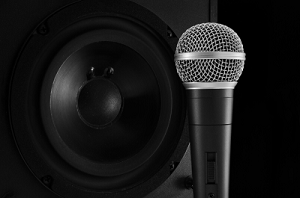Correct Microphone Technique For Singers - How To Improve Your Singing for Beginners

Most people feel that using a microphone only requires simply picking it up and singing into it. The reality is that one must learn how to use a microphone correctly in order to benefit from its specially-designed features and to obtain optimal sound quality. To improve your singing, giving adequate attention to a good vocal microphone technique is equally important. How you hold and use a microphone is important, and I am going to lay down some basic useful microphone tips for beginners if you want to sing better.
A good microphone technique will compliment your voice
Do you know that how you hold the microphone can affect your singing?
Tips for Holding and Using the Microphone for Beginners to Improve the Singing Voice and Sound Quality
Learn these simple but extremely important tips for beginners on the proper handling of the microphone to improve the singing.
Tip # 1 Do Not Hold Rounded Front or Top of Microphone
Microphones are designed to be held a specific way. Do not hold the rounded shell of the microphone which is closest to your mouth, but hold around the long cylindrical part of the microphone, keeping your hand away from the shell, as any interference with the shell will lead to an increased chance of sound feedback or disturbance. The manufacturer's data sheet for the microphone is generally the best starting point in determining how to use a specific microphone.
Tip # 2 Point Microphone Towards Your Mouth
Orient the microphone towards your mouth so that your voice travels directly into the pickup pattern of the microphone. Hold the microphone at an angle that is perpendicular to your face. Do not sing across the top of the microphone, with the microphone pointed towards the ceiling, because this will result in a thin, weak sound being captured by the microphone. If you move your head in different directions while singing, the microphone should also follow these head movements.
Tip # 3 Get Close to the Microphone
Don't be afraid to get close to the microphone while singing. Depending on the microphone, a good working distance is typically between one and four inches away from your mouth, unless you are singing really high and loud notes. The closer in, the more the lows are emphasized. The farther away, the less low end is emphasized, and thus the thinner the sound becomes. If this is too far away, you will get more room sound and ambience (or background noise). In some cases, the microphone will lose its clarity from distances greater than its working field.
Tip # 4 Position Microphone Equally Distanced, When Sharing Microphone With Another Person
When sharing a microphone, the microphone should be positioned so that all the voices are distanced equally within the microphone's pickup pattern.
Tip # 5 Do Not Hold Microphone Too Far Away For High and Loud Notes
The temptation for singers is to hold their microphones a foot away from their mouths when singing higher and louder notes, and then move them closer again for other sections of the song, can sometimes be a bad way. Because microphones pick up sound best at certain distances and certain directions, being too far away from the microphone can thin the voice, which is the opposite result that a singer desires when attempting to show off a powerful higher note. If it is too far away, the voice, no matter how loud it seems to you, may not be picked up effectively, leading to inconsistent volume and tone.
Tip # 6 Keep Height of Microphone on Stand at Level of Mouth
When placing your microphone on a stand, raise or lower the stand so that you sing directly into the microphone. Raising or lowering your chin while singing produces excess tension in your neck and jaw muscles, which can affect your proper singing.

Selecting & Purchasing Your Correct Microphone
Selection: Select and purchase the microphone most suited to the physical situation in which you will be using it. For example, if you will be using the microphone in a live setting, don't purchase one that is intended for use in a recording studio. Many types of microphones have been invented for different purposes and different situations, and how particular microphones translate sound, and the type of sound being captured will help to determine which microphone you will want to purchase.
Find the right quality microphone that enhances the features of your voice and captures the sound of your voice at its optimum quality, in terms of both tone and balance. Anything less (e.g. a cheap microphone) will degrade your voice. The vocal microphones are the most important link in the sound system, so buy the best microphone that you can afford, the one that is most suited to your particular voice and its unique qualities and range.
Testing: Test each microphone, and set the equalizer of the amplifier to flat (i.e. no extra treble, bass, etc.), so that you are hearing the real differences among different microphones. Listen closely and critically to how your voice sounds through good speakers. Your suitable microphone must be able to accentuate your voice's tone.
Customer Reviews: Ensure that there is a good manufacturer's warranty for the microphone, and search the internet for customer reviews of the product.
Reference Books



Learn to Sing Better
Both (1) correct technique for holding and using the microphone, and (2) a good microphone selection, as explained above, will complement your singing voice, but they cannot overcome or cover up poor singing techniques. Improvements must also come from you with proper singing techniques and lessons. If you want to achieve the ability to sing well, CLICK HERE to learn some Easy Tips on How to Sing Better for Beginners.
© 2011 mySuccess8





